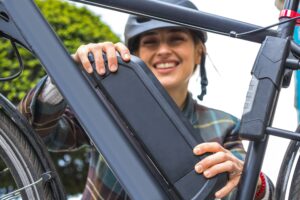Your e-bike battery is the most expensive single component on the bike and the one that most determines range, reliability, and day-to-day happiness. Treated well, modern lithium-ion packs routinely last 3–5 years (many reach 6–7). Treated poorly, they can feel “tired” in a season. This guide covers exactly how to charge, store, ride, and care for your battery so it lasts as long as possible.
Battery Basics (What You’re Actually Riding)
Most branded e-bikes use lithium-ion cells arranged into a pack with a Battery Management System (BMS). Common chemistries:
- NMC (Nickel Manganese Cobalt): Most common; great energy density and power.
- LFP (Lithium Iron Phosphate): Heavier, slightly lower energy density, but excellent lifespan and thermal stability.
- Cells & formats: 18650 or 21700 cylindrical cells; quality varies a lot by supplier.
- The BMS: The “brains” that monitors cell voltages, temperature, charge/discharge limits, and balancing. If the BMS trips (over-temp, under-voltage), it may cut power to protect the pack.
Implication for owners: Chemistry and BMS matter, but your habits (charging, temperature, storage) have the biggest impact over time.
Daily Charging: Habits That Add Years
1) Don’t routinely run to 0%.
Aim to finish most rides with 20–40% remaining. Deeply discharging to empty accelerates wear and can trigger BMS low-voltage cutoffs.
2) Don’t park it at 100% for long.
High state-of-charge stresses cells. For everyday use, charge to ~80–90%. Save a full 100% only for the nights before long rides.
3) Partial charges are healthy.
Topping from 40% → 80% is easier on the pack than 10% → 100%. Lithium-ion has no “memory effect.”
4) Use the original (OEM) charger.
Third-party chargers may mismanage voltage or lack proper protections. If you need a spare, buy the official model for your bike.
– OEM Replacement Charger
5) Charge on a stable, non-flammable surface.
Concrete, tile, metal tray. Keep clear of paper, bedding, and solvents. Don’t drape the charger or battery with clothes (heat needs to dissipate).
6) Don’t leave it on the charger for days.
Once you hit the target (80–90% for daily use, 100% for long rides), unplug. Many chargers float at high voltage; minimizing time at max voltage helps longevity.
7) If your brand offers an “80% mode” or scheduled charging—use it.
Some systems (smart chargers/bikes) let you cap at 80–90% or schedule a finish time before a ride. That’s ideal.
Pro routine:
- Commute day: Ride → plug in at home for 1–2 hours to ~80–90% → unplug.
- Big weekend ride: The night before, top up to 100%; ride shortly after it completes.
Temperature: The Silent Battery Killer
Operating sweet spot: 50–77°F (10–25°C).
Charging sweet spot: 60–77°F (15–25°C).
- Cold (<32°F / 0°C): Expect less range. Store the battery indoors; install it just before you ride. Don’t fast-charge a stone-cold pack.
- Heat (>95°F / 35°C): Heat ages cells quickly. Avoid hot cars, direct sun, unventilated sheds, or attic storage. If the pack feels hot, let it cool before charging.
Rule of thumb: You can ride cold; you should charge warm (room temp). You can ride warm; you should store cool.
Storage: Short Breaks, Off-Season, and “Life Happens”
Short breaks (a few days):
Leave the pack ~50–70%. No need to fuss.
Off-season (weeks to months):
- Charge or discharge to ~40–60%.
- Store in a cool, dry place (ideally 50–70°F / 10–21°C).
- Check every 1–2 months; if it drifts below ~30–35%, top back to ~50%.
- Don’t store it at 0% (risk of dropping below the BMS recovery threshold) or at 100% (high-voltage stress).
Moisture & corrosion:
Wipe contacts dry before storage. If you live near the coast or ride in rain frequently, a thin film of dielectric grease on contacts helps (brand-approved only).
Riding & Range Habits That Protect the Pack
- Start in an easy gear. High torque at low cadence spikes current draw; that heats cells. Spin up smoothly, then shift.
- Use eco/low assist on flats. Save high assist for hills and headwinds. Lower current draw = cooler cells = less wear.
- Tire pressure matters. Under-inflated fat tires can double rolling resistance. Keep to the brand’s recommended range for your terrain.
- Keep the drivetrain clean. Dirty chains waste watts; you’ll feel it in reduced range.
- Stop-and-go? Use lower assist when starting, then bump it up as you roll.
Range reality check:
If your normal loop ends with ~30–40% left, you’re in the sweet spot. If you routinely limp home at 5–10%, consider a bigger pack, a spare, or lighter assist strategy.
Cleaning & Handling (and What Not to Do)
- Remove the battery before washing. Never pressure-wash the battery or ports.
- Hand-wash only. Damp cloth on the case; keep ports dry.
- Inspect for damage. Cracks, punctures, swelling, melted plastic, or burnt smells = stop using and contact the brand/dealer.
- Don’t open the pack. It voids warranties and risks short circuits. Leave repairs to qualified technicians.
Transport & Travel
- On car racks: Remove the battery to reduce weight/bounce; keep it padded inside the vehicle.
- Air travel: Almost no airline will allow full-size e-bike batteries in checked or carry-on luggage. Plan to rent a battery at your destination or ship ground via a certified hazmat carrier.
- Shipping: Lithium-ion is regulated. Use manufacturer guidance, UN-rated packaging, and approved carriers.
Troubleshooting: Is My Battery “Aging” or Just Out of Tune?
Normal signs of aging (after hundreds of cycles):
- 10–20% less range than new.
- Voltage sags harder on steep climbs/high assist.
- Pack takes slightly less Wh to “fill.”
Actions to try before declaring it “done”:
- Balance charge (if brand supports it): A slow, uninterrupted full charge can allow the BMS to equalize cells.
- Firmware updates: Some bike systems improve accuracy of range estimates over time.
- Check magnets/assist sensors/drivetrain drag: Mechanical issues can masquerade as battery issues.
When to replace:
- Range has dropped >30% vs new and affects your typical ride.
- BMS repeatedly trips or the charger refuses to complete cycles.
- Visible, physical damage or water intrusion.
Replacement tips:
- Buy OEM or brand-approved packs only. Counterfeits are common and risky.
- Keep the old pack for short trips if it’s safe, or recycle it (below).
Safety Checklist (Worth Reviewing Once a Season)
- Charge on non-flammable surfaces with space around the charger.
- Avoid charging unattended overnight.
- Use only OEM chargers and cords in good condition.
- Keep away from heat sources and direct sun.
- If the pack is damaged, stop using and contact the brand/dealer.
Optional safety add-ons:
- Fire-resistant Battery Storage Bag
- Smart Plug / Timer to stop charging after 2–3 hours
- Infrared Thermometer to spot unusually hot packs or chargers
FAQ: Fast Answers to Common Owner Questions
Q: Do I need to “calibrate” my battery?
A: Not like old NiMH packs. Some systems estimate state-of-charge better if you do a full ride-to-low followed by a full, uninterrupted charge once every few months—but don’t make that your daily routine.
Q: Is it bad to charge after every ride?
A: No. Frequent partial charges (e.g., 40 → 80%) are gentle. Just avoid parking at 100% for days on end.
Q: Can I ride in heavy rain?
A: Many systems are water-resistant, but avoid submersion and high-pressure sprays. Dry the battery and ports after wet rides before charging.
Q: My range tanked in winter—does that mean the battery is dying?
A: Probably not. Cold reduces available capacity temporarily. Store and charge warm; expect better range as temps rise.
Q: How long will my battery last?
A: Most riders get 500–1,000 full charge cycles (3–5+ years). Your habits make the biggest difference.
Recycling & End-of-Life
Never toss lithium-ion batteries in the trash. Use a certified recycler or your local e-bike dealer. Many brands participate in programs (e.g., Call2Recycle in the U.S.) that safely process e-bike packs.
Quick Reference: Do / Don’t
Do
- Keep daily SOC between ~20–90%
- Store ~40–60% if unused for weeks
- Charge and store at room temp
- Use OEM chargers only
- Remove the battery for car-rack travel
- Clean contacts, keep ports dry
Don’t
- Park at 0% or 100% for long periods
- Charge on beds/sofas/carpets
- Pressure-wash the battery
- Leave it in hot cars/sun
- Ignore physical damage or BMS faults
Recommended Accessories (Nice-to-Haves)
- OEM Spare Charger — one for home, one for work/van.
- Fire-Resistant Storage Bag or Metal Box — extra peace of mind in apartments/RVs.
- Smart Plug/Timer — helps avoid sitting at 100%.
- Weatherproof Port Covers — if your brand offers them.
The Bottom Line
Think of battery care as three simple rules: avoid extremes, minimize time at 100%, and keep it cool and dry. Do that, and you’ll see consistent range, fewer headaches, and a pack that lasts years longer than the folks who treat their batteries like phone chargers.
Related Links:
- Best Fat Tire E-Bikes Guide
- Best Commuter E-Bikes Guide
- Ride1Up Review
- Best Gravel Bikes Guide
- Best E-Bikes Guide
Why Trust This Guide?
Jeffrey South is the founder of Best Bike Brands. With over 30 years in the cycling world as a shop owner, mechanic, and industry insider, he now shares reviews, guides, and insights to help riders choose the best bikes and gear with confidence.




